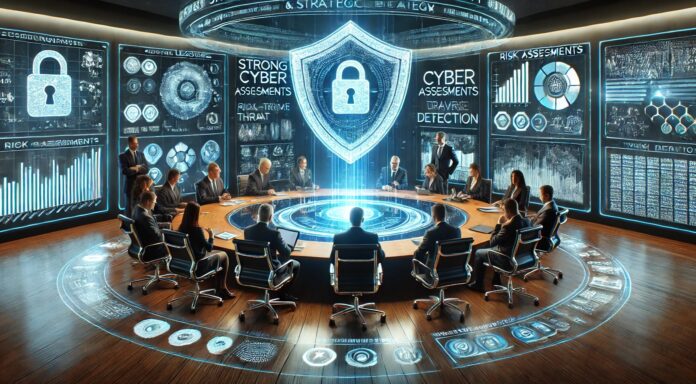
In today’s ever-evolving threat landscape, cybersecurity is no longer just a technical concern—it’s a business imperative. Yet, new research from Cyber Defense Group (CDG) reveals a critical disconnect between executives and security teams when it comes to confidence in their organization’s resilience. While 92% of IT security professionals express confidence in their ability to manage threats, the frequency of breaches and the projected rise in 2025 security budgets indicate underlying vulnerabilities that remain unaddressed.
The 2025 Cybersecurity Strategy Insights Report, based on insights from 300 U.S. IT security professionals, sheds light on misalignments that undermine security strategies. As cyber threats grow in sophistication, organizations must shift from a siloed approach to a cohesive, ecosystem-driven strategy that bridges the gap between technical teams and leadership.
The Executive Confidence Gap in Security Posture
A striking disparity in confidence exists between different leadership roles, which may be influencing cybersecurity strategies—or lack thereof. Two-thirds (68%) of CEOs surveyed reported high confidence in their organization’s security posture. This optimism likely stems from their involvement in hiring security leaders and shaping overarching strategies. However, their distance from day-to-day threat intelligence and incident response may obscure the real risks facing their organizations.
On the other hand, CIOs and CSOs, who work closer to security operations, paint a different picture. Only 31% of CIOs reported being very confident in their security posture, while the majority expressed moderate confidence. Among CSOs, confidence levels were even lower—only 5% felt highly assured in their ability to mitigate threats. These findings suggest that those closest to security challenges have a more measured view, recognizing the gaps that still need to be addressed.
Organizational Structures and the Need for an Agile Security Model
Security teams are structured in various ways, with most organizations relying on a mix of in-house staff and contractors (39%) or fully in-house teams (36%). However, the report found a growing trend toward external support, with 25% of respondents investing in part-time or fractional security roles or outsourcing their cybersecurity functions entirely. Across all security team structures, respondents identified key areas for improvement:
- Speed and flexibility (58%)
- Cohesive strategy and program development (54%)
- Specialized expertise to counter advanced threats (52%)
- Enhanced executive-level oversight and visibility (42%)
- Addressing budget limitations without compromising security (42%)
This data underscores the need for organizations to adopt more dynamic security models that can scale as threats evolve.
Breaches, Budget Constraints, and Talent Shortages Exacerbate Risk
One of the most concerning findings from the report is the sheer volume of security incidents organizations have faced. Nearly one in two respondents (49%) reported experiencing a breach in the past year, including data exfiltration, ransomware attacks, and unauthorized access. Yet, despite this alarming trend, security budgets saw only an 8% increase in 2024, according to IANS Research.
Adding to the challenge is a severe cybersecurity talent shortage. The U.S. alone faces a deficit of over 225,200 security professionals, with approximately 470,000 open cybersecurity jobs. This shortfall creates a skills gap that leaves organizations vulnerable, especially as AI-powered threats continue to evolve at an unprecedented rate.
The Rise of vCISOs: A Strategic Solution to Bridge Security Gaps
Faced with rising threats and resource constraints, organizations are increasingly turning to virtual chief information security officers (vCISOs) to bridge gaps in oversight, expertise, and business alignment. CDG’s report highlights a growing recognition of the benefits of vCISOs, with 76% of security leaders planning budget increases in 2025 to address evolving risks.
The benefits of vCISOs include:
- Cost-effective leadership without the overhead of a full-time CISO (28%)
- Flexible, on-demand expertise that scales as needed (19%)
- Strategic oversight and alignment with business goals (15%)
- Specialized knowledge for temporary or critical security needs (12%)
- Filling skills gaps without requiring a full-time hire (11%)
By integrating vCISOs into their cybersecurity strategy, organizations gain access to seasoned leadership capable of balancing security priorities with broader business objectives.
A Call to Action: Building an Ecosystem Approach to Cybersecurity
Organizations can no longer afford to approach cybersecurity in silos. The rapid evolution of cyber threats, coupled with insights from the 2025 Cybersecurity Strategy Insights Report, underscores the need for a more integrated, strategic approach. Rather than relying on fragmented security measures, businesses must align leadership, strategy, and cybersecurity resources to build a resilient defense framework. This requires fostering collaboration between executives and security teams, adopting dynamic security models, and leveraging external expertise such as vCISOs to drive meaningful, outcomes-based protection. By shifting from reactive responses to a proactive, ecosystem-driven approach, organizations can close the confidence gap between technical teams and leadership, ensuring they are prepared to navigate the challenges of 2025 and beyond.
Ad
Join over 500,000 cybersecurity professionals in our LinkedIn group “Information Security Community”!
